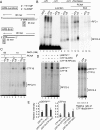Human CTF18-RFC clamp-loader complexed with non-synthesising DNA polymerase ε efficiently loads the PCNA sliding clamp
- PMID: 28199690
- PMCID: PMC5416766
- DOI: 10.1093/nar/gkx096
Human CTF18-RFC clamp-loader complexed with non-synthesising DNA polymerase ε efficiently loads the PCNA sliding clamp
Abstract
The alternative proliferating-cell nuclear antigen (PCNA)-loader CTF18-RFC forms a stable complex with DNA polymerase ε (Polε). We observed that, under near-physiological conditions, CTF18-RFC alone loaded PCNA inefficiently, but loaded it efficiently when complexed with Polε. During efficient PCNA loading, CTF18-RFC and Polε assembled at a 3΄ primer-template junction cooperatively, and directed PCNA to the loading site. Site-specific photo-crosslinking of directly interacting proteins at the primer-template junction showed similar cooperative binding, in which the catalytic N-terminal portion of Polε acted as the major docking protein. In the PCNA-loading intermediate with ATPγS, binding of CTF18 to the DNA structures increased, suggesting transient access of CTF18-RFC to the primer terminus. Polε placed in DNA synthesis mode using a substrate DNA with a deoxidised 3΄ primer end did not stimulate PCNA loading, suggesting that DNA synthesis and PCNA loading are mutually exclusive at the 3΄ primer-template junction. Furthermore, PCNA and CTF18-RFC-Polε complex engaged in stable trimeric assembly on the template DNA and synthesised DNA efficiently. Thus, CTF18-RFC appears to be involved in leading-strand DNA synthesis through its interaction with Polε, and can load PCNA onto DNA when Polε is not in DNA synthesis mode to restore DNA synthesis.
© The Author(s) 2017. Published by Oxford University Press on behalf of Nucleic Acids Research.
Figures








Similar articles
-
Mechanism of PCNA loading by Ctf18-RFC for leading-strand DNA synthesis.Science. 2024 Aug 2;385(6708):eadk5901. doi: 10.1126/science.adk5901. Epub 2024 Aug 2. Science. 2024. PMID: 39088616 Free PMC article.
-
Stable interaction between the human proliferating cell nuclear antigen loader complex Ctf18-replication factor C (RFC) and DNA polymerase {epsilon} is mediated by the cohesion-specific subunits, Ctf18, Dcc1, and Ctf8.J Biol Chem. 2010 Nov 5;285(45):34608-15. doi: 10.1074/jbc.M110.166710. Epub 2010 Sep 7. J Biol Chem. 2010. PMID: 20826785 Free PMC article.
-
Cryo-EM reveals a nearly complete PCNA loading process and unique features of the human alternative clamp loader CTF18-RFC.Proc Natl Acad Sci U S A. 2024 Apr 30;121(18):e2319727121. doi: 10.1073/pnas.2319727121. Epub 2024 Apr 26. Proc Natl Acad Sci U S A. 2024. PMID: 38669181 Free PMC article.
-
Functions of Multiple Clamp and Clamp-Loader Complexes in Eukaryotic DNA Replication.Adv Exp Med Biol. 2017;1042:135-162. doi: 10.1007/978-981-10-6955-0_7. Adv Exp Med Biol. 2017. PMID: 29357057 Review.
-
The PCNA-RFC families of DNA clamps and clamp loaders.Prog Nucleic Acid Res Mol Biol. 2004;78:227-60. doi: 10.1016/S0079-6603(04)78006-X. Prog Nucleic Acid Res Mol Biol. 2004. PMID: 15210332 Review.
Cited by
-
The proofreading exonuclease of leading-strand DNA polymerase epsilon prevents replication fork collapse at broken template strands.Nucleic Acids Res. 2023 Dec 11;51(22):12288-12302. doi: 10.1093/nar/gkad999. Nucleic Acids Res. 2023. PMID: 37944988 Free PMC article.
-
MMS22L-TONSL functions in sister chromatid cohesion in a pathway parallel to DSCC1-RFC.Life Sci Alliance. 2022 Dec 8;6(2):e202201596. doi: 10.26508/lsa.202201596. Print 2023 Feb. Life Sci Alliance. 2022. PMID: 36622344 Free PMC article.
-
Structure of the human CTF18-RFC clamp loader bound to PCNA.bioRxiv [Preprint]. 2025 Jul 24:2024.05.08.593111. doi: 10.1101/2024.05.08.593111. bioRxiv. 2025. PMID: 40777363 Free PMC article. Preprint.
-
Regulation of PCNA cycling on replicating DNA by RFC and RFC-like complexes.Nat Commun. 2019 Jun 3;10(1):2420. doi: 10.1038/s41467-019-10376-w. Nat Commun. 2019. PMID: 31160570 Free PMC article.
-
The human ATAD5 has evolved unique structural elements to function exclusively as a PCNA unloader.Nat Struct Mol Biol. 2024 Nov;31(11):1680-1691. doi: 10.1038/s41594-024-01332-4. Epub 2024 Jun 13. Nat Struct Mol Biol. 2024. PMID: 38871854 Free PMC article.
References
MeSH terms
Substances
LinkOut - more resources
Full Text Sources
Other Literature Sources
Molecular Biology Databases
Miscellaneous

